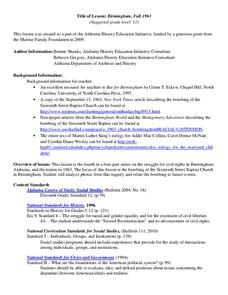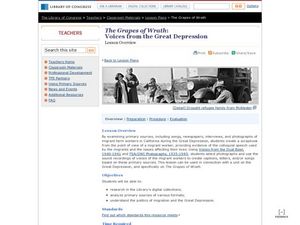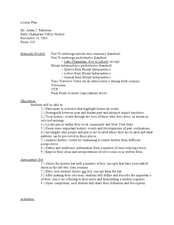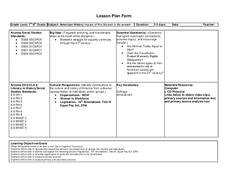Curated OER
Can You Hear Me Now?
Students explore the industry involving communication and put communication devices into activities. In this communication lesson plan, students put items into chronological order, review primary sources, compare and contrast items, and...
Curated OER
World War I
Eleventh graders investigate propaganda used during World War I. In this World War I lesson, 11th graders examine propaganda from the war and analyze war posters. Students then create their own propaganda posters on listed topics.
Albert Shanker Institute
Economic Causes of the March on Washington
Money can't buy happiness, but it can put food on the table and pay the bills. The first of a five-lesson unit teaches pupils about the unemployment rate in 1963 and its relationship with the March on Washington. They learn how to create...
Los Angeles Unified School District
Capitalism and Socialism
Capitalism, socialism, communism ... these may seem like a whole bunch of isms to your scholars. High schoolers won't confuse them after completing an informative resource. Your class masters how to use primary sources to critically...
Humanities Texas
A President's Vision: George Washington
Who knew that one poster about George Washington could have so many learning possibilities attached to it? Here you'll find an attractive learning display on the first president of the United States, as well as worksheets and...
Alabama Department of Archives and History
Birmingham, Fall 1963
Can any good come from acts of evil? The 1963 bombing of the Sixteenth Street Baptist Church in Birmingham, Alabama, and the eventual outcomes of the tragedy, are the focus of a lesson that asks groups to examine primary source documents...
National Park Service
Should America Have Gone to War in 1812?
Using an incredibly engaging activity and detailed lesson plan, your learners will serve as advisors to President Madison on whether to participate in what would become the War of 1812! Utilize a variety of effective instructional...
Curated OER
Carter’s Approach to Facing the Energy Crisis
High schoolers examine President Carter's stance on the energy crisis of the 1970s. In this energy crisis instructional activity, students analyze primary sources that feature the crisis during Carter's term. High schoolers script and...
Curated OER
The Grapes of Wrath: Voices from the Great Depression
Students research the Great Depression. In this Great Depression lesson, students analyze primary sources to develop an understanding of the plight of migrant farm workers during the Great Depression as they read Steinbeck's The...
Curated OER
Discover the Real Depression
Eleventh graders take a closer look at living conditions during the Great Depression. In this Great Depression lesson, 11th graders analyze primary source packets that their teachers prepare and then record facts about life for Americans...
Curated OER
World War II
Students analyze primary sources (photographs) for evidence of American military technology during WWII. They debate the use of the Atomic Bomb. Students view the Rosenthal image. They discuss the image in detail.
Curated OER
Indian Boarding Schools
Pupils research government-run American Indian boarding schools. In this American Indian history lesson, students analyze primary documents to develop an understanding of the forced acculturation of American Indians through...
Curated OER
Early Champlain Valley History
Class members use primary sources to craft an essay about early Champlain Valley History. I would use this as a homework assignment.
Library of Congress
Determining Point of View: Paul Revere and the Boston Massacre
If you're teaching point of view, this is the lesson for you! First, decipher the writer's point of view from a primary resource, then compare and contrast the primary source with a secondary source to explore the Paul Revere's engraving...
University of Pennsylvania
Using Comic Strips to Teach Multiple Perspectives
Scholars view comics from two different perspectives; one paints the Alfred Dreyfus as innocent, while the other portrays the exact opposite. They solve the mystery of what happened by analyzing the source, working in groups, and...
Jamestown-Yorktown Foundation
Making a Patriot Inquiry: Are Independence, Freedom, and Liberty the Same Thing?
As part of a study of the American Revolution, class members engage in an inquiry-based lesson that has them watch a scene from the play Slave Spy, examine multiple primary source documents, and then discuss the similarities and...
Arizona Department of Education
American History Impact of the Women’s Movement
Take a look at important images that depict the women's suffrage movement, the support for the Equal Rights Amendment, and wage equity for women over the last two centuries. As class members work through a instructional activity on...
American Battlefield Trust
1861: The Country Goes to War
What was it like to know the Civil War was coming? Using a graphic timeline activity and excerpts of speeches from Abraham Lincoln and Jefferson Davis, learners consider the early days of the conflict. The resource includes prompts for...
K20 Learn
American Exclusivity: The Chinese Exclusion Act
The Chinese Exclusion Act—the first race-based immigration restriction—is echoed in today's debates on the topic. Using graphic organizers and structured discussions, historians consider the reasons behind the act and compare the...
Daughters of the American Revolution
Lesson 1: How Do Society’s Expectations Influence Education?
The history of women's education can be traced back to the delicate stitching of student samplers from the 19th century. Modern-day pupils examine and analyze four primary sources, three of which are images of embroidered samplers, which...
Library of Congress
Women's Suffrage Movement Across America
An engaging resource provides many primary source materials to inform a study of the Women's Suffrage Movement. Suggestions include building a timeline of the fight, using the documents as the basis of a DBQ, and/or using a Venn diagram...
CHPCS
The United States in the 1920s: The New Negro Movement and the Harlem Renaissance
Music, writing, and activism all tell the story of history! The resource uses these elements and more in a presentation to discuss the Jazz Age and Harlem Renaissance. Your class views biographies, discusses important events, and...
New York State Education Department
Global History and Geography Examination: August 2015
Need a comprehensive test about global history and geography? Look no further! Test young historians' understanding of how to use primary sources to formulate answers with an assessment that uses multiple-choice questions that require a...
Curated OER
Man's Best Friend:The Old Drum Story
Students explore the Missouri courts. In this primary sources lesson, students examine the Missouri court case Burden v. Hornsby as well as other primary documents and narratives relating to the case. Students analyze the case as they...

























